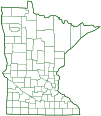southern obedient plant
(Physostegia virginiana ssp. praemorsa)
Conservation • Wetland • Description • Habitat • Ecology • Use • Distribution • Taxonomy
Conservation Status |
|
|||||||
| IUCN Red List | not listed |
|||||||
| NatureServe | NNR - Unranked SNR - Unranked |
|||||||
| Minnesota | not listed |
|||||||
Wetland Indicator Status |
||||||||
| Great Plains | FACW - Facultative wetland |
|||||||
| Midwest | FACW - Facultative wetland |
|||||||
| Northcentral & Northeast | FACW - Facultative wetland |
|||||||
Description |
||
Southern obedient plant is a 2′ to 5′ tall, erect, perennial forb that rises on multiple stems clustered on a short caudex. The stems are erect, hairless, 4-angled, and hollow. They have 10 to 34 opposite pairs of leaves and are often branched near the top with several racemes. The leaves are opposite, hairless, lance-shaped or inversely egg-shaped, up to 5″ long and 1½″ wide. The bottom 1 to 7 pairs may be stalked and soon fall off. The remaining leaves are stalkless. The margins are toothed usually with sharp teeth, sometimes with blunt teeth, or are rarely untoothed. The inflorescence is a elongated, unbranched cluster (raceme) at the ends of the stems and branches. The racemes are 2″ to 6″ long when in flower and have 4 rows of densely packed flowers that mature from the bottom up. There are usually some empty floral bracts below the inflorescence. When moved left or right the individual flowers stay where they are moved, hence the name “obedient plant”. The flowers are ⅔″ to 1⅓″ long. The 5 sepals are green, ¼″ long, and are fused at the base into a tube with 5 sharply pointed lobes. The 5 petals are pink with purple spots on the inside. They are fused at the base into a tube with 2 lips. The upper lip is broad, hood-like, and overhanging. The lower lip is divided into a broad central lobe and 2 smaller lateral lobes. There are 4 stamens with purple anthers visible under the upper lip. There is no floral scent. The fruit is a smooth nutlet with 1 seed. |
||
Height |
||
2′ to 5′ |
||
Flower Color |
||
Pink |
||
Similar Species |
||
Obedient plant (Physostegia virginiana ssp. virginiana) stems are scattered along a long, horizontal rhizome. There are no empty floral bracts below the inflorescence. |
||
Habitat |
||
Dry to moderate moisture. Prairies, open woods. Full to partial sun. |
||
Ecology |
||
Flowering |
||
August to October |
||
Pests and Diseases |
||
|
||
Use |
||
|
||
Distribution |
||||
|
Sources |
|||
| 6/18/2023 | ||||
Nativity |
||||
Native (?) |
||||
Occurrence |
||||
USDA PLANTS shows this species as native to Minnesota. However, no records can be found. |
||||
Taxonomy |
|||
| Kingdom | Plantae (green algae and land plants) | ||
| Subkingdom | Viridiplantae (green plants) | ||
| Infrakingdom | Streptophyta (land plants and green algae) | ||
| Superdivision | Embryophyta (land plants) | ||
| Division | Tracheophyta (vascular plants) | ||
| Subdivision | Spermatophytina (seed plants) | ||
| Class | Magnoliopsida (flowering plants) | ||
| Superorder | Asteranae | ||
Order |
Lamiales (mints, plantains, olives, and allies) | ||
Family |
Lamiaceae (mint) | ||
| Subfamily | Lamioideae | ||
| Tribe | Synandreae | ||
| Genus | Physostegia (dragonheads and obedient plants) | ||
| Species | Physostegia virginiana (obedient plant) | ||
Physostegia virginiana is a highly variable species. Many varieties and subspecies have been described. An analysis of several varieties and subspecies (Cantino, 1982) concluded that only two subspecies should be recognized, and they roughly equate to the northern and the southern groups. The northern subspecies P. v. ssp. virginiana is the only subspecies that occurs in Minnesota. USDA PLANTS shows the southern subspecies P. v. ssp. praemorsa also native to Minnesota, however no records of that subspecies in the state can be found. |
|||
Synonyms |
|||
Physostegia praemorsa Physostegia serotina Physostegia virginiana var. arenaria Physostegia virginiana var. reducta |
|||
Common Names |
|||
false dragonhead obedience southern obedient plant obedient plant obedient-plant |
|||
Glossary
Caudex
A short, thickened, woody, persistent enlargement of the stem, at or below ground level, used for water storage.
Raceme
An unbranched, elongated inflorescence with stalked flowers. The flowers mature from the bottom up.
Rhizome
A horizontal, usually underground stem. It serves as a reproductive structure, producing roots below and shoots above at the nodes.
Sepal
An outer floral leaf, usually green but sometimes colored, at the base of a flower.
Visitor Photos |
|||||
Share your photo of this plant. |
|||||
| This button not working for you? Simply email us at info@MinnesotaSeasons.com. Attach one or more photos and, if you like, a caption. |
|||||
|
|||||
MinnesotaSeasons.com Photos |
|||||
|
|||||

Visitor Videos |
|||
Share your video of this plant. |
|||
| This button not working for you? Simply email us at info@MinnesotaSeasons.com. Attach a video, a YouTube link, or a cloud storage link. |
|||
Other Videos |
|||

Visitor Sightings |
|||||
Report a sighting of this plant. |
|||||
| This button not working for you? Simply email us at info@MinnesotaSeasons.com. Be sure to include a location. |
|||||
|
|||||
MinnesotaSeasons.com Sightings |
|||||
|
|||||

|
Created: Last Updated: © MinnesotaSeasons.com. All rights reserved. |


